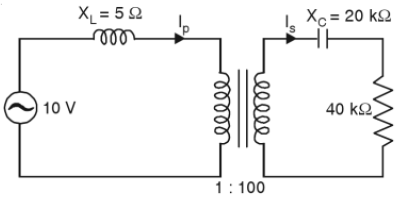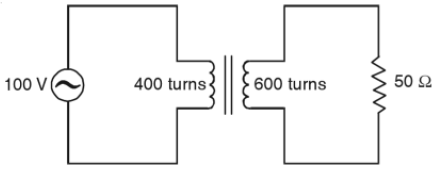
41. The impedance seen by the primary in Fig. 5 is
(i) 5 Ω
(ii) 25 Ω
(iii) 625 Ω
(iv) none of the above
Answer: (ii) 25 Ω
42. The primary current Ip in Fig. 5 is
(i) 2 A
(ii) 0.04 A
(iii) 0.004 A
(iv) none of the above
Answer: (i) 2 A
43. The voltage across 40 KΩ resistor in Fig. 5 is
(i) 1000 V
(ii) 500 V
(iii) 800 V
(iv) none of the above
Answer: (iii) 800 V
44. The voltage across 20 KΩ capacitor in Fig. 5 is
(i) 200 V
(ii) 400 V
(iii) 1000 V
(iv) none of the above
Answer: (ii) 400 V
45. The secondary current Is in Fig. 5 is
(i) 1.25 A
(ii) 50 A
(iii) 0.02 A
(iv) none of the above
Answer: (iii) 0.02 A
46. Cores of large transformers are built upto nearly circular cross-section in order to reduce
(i) leakage reactance
(ii) iron losses
(iii) eddy current loss
(iv) copper loss
Answer: (iv) copper loss
47. The core-type transformer provides
(i) much longer magnetic path
(ii) shorter magnetic path
(iii) lesser average length per turn
(iv) none of the above
Answer: (ii) shorter magnetic path
48. The core-type transformer is generally suitable for
(i) high voltage and small output
(ii) high voltage and high output
(iii) low voltage and high output
(iv) none of the above
Answer: (i) high voltage and small output
49. Transformers having ratings less than 5 k VA are generally
(i) oil cooled
(ii) natural air cooled
(iii) water cooled
(iv) none of the above
Answer: (ii) natural air cooled
50. The transformer that should never have the secondary open-circuited when primary is energised is
(i) power transformer
(ii) voltage transformer
(ii) auto transformer
(iv) current transformer
Answer: (iv) current transformer
51. The temperature rise of a transformer is directly proportional to
(i) apparent power
(ii) reactive power
(iii) leakage reactance
(iv) none of the above
Answer: (i) apparent power
52. In an auto transformer, the primary and secondary are ………. coupled.
(i) only magnetically
(ii) only electrically
(iii) magnetically as well as electrically
(iv) none of the above
Answer: (iii) magnetically as well as electrically

53. The impedance reflected back to the source in Fig. 6 is
(i) 11.2 Ω
(ii) 22.2 Ω
(iii) 25 Ω
(iv) 47.8 Ω
Answer: (ii) 22.2 Ω
54. The secondary load impedance of a step-up transformer is Zs The primary impedance will be
(i) equal to Zs
(ii) greater than Zs
(iii) less than Zs
(iv) none of the above
Answer: (iii) less than Zs
55. The steel used for transformer core has
(i) high silicon content
(ii) high permeability
(iii) low hysteresis loss
(iv) all of the above
Answer: (iv) all of the above
56. In a transformer, leakage flux
(i) helps in transfer of energy
(ii) is negligible at full-load
(iii) is minimised by interleaving the primary and secondary windings.
(iv) produces mutually induced e.m.f.
Answer: (iii) is minimised by interleaving the primary and secondary windings.
57. Short-circuit test of a transformer helps us to find its
(i) iron loss
(ii) full-load Cu loss
(iii) Cu loss at no load
(iv) none of the above
Answer: (ii) full-load Cu loss
58. A two-winding transformer operates at maximum efficiency when its
(i) hysteresis loss equals eddy current loss
(ii) Cu loss equals iron loss
(iii) primary resistance equals secondary resistance
(iv) voltage regulation is minimum.
Answer: (ii) Cu loss equals iron loss
59. The all-day efficiency of a transformer is also called its
(i) energy efficiency
(ii) power efficiency
(iii) current efficiency
(iv) none of the above
Answer: (i) energy efficiency
60. The short-circuit test helps us to find
(i) Cu loss at any desired load
(ii) iron loss at no load
(iii) Cu loss at no load
(iv) none of the above
Answer: (i) Cu loss at any desired load
61. The power efficiency of a lighting transformer is always ………. its all-day efficiency.
(i) equal to
(ii) higher than
(iii) less than
(iv) none of the above
Answer: (ii) higher than
62. With a load of leading power factor, the full load secondary voltage of a transformer is ……… its no-load voltage.
(i) equal to
(ii) less than
(iii) greater than
(iv) none of the above
Answer: (iii) greater than
63. What is the approximate efficiency of large transformers ?
(i) 65 %
(ii) 75 %
(ii) 85 %
(iv) 95 %
Answer: (iv) 95 %
64. An isolation transformer has primary to secondary turns ratio of
(i) 1 : 1
(ii) 1 : 2
(iii) 2 : 1
(iv) can be any ratio
Answer: (i) 1 : 1
65. The load on a transformer is 2 ∠0o Ω or 2 ∠20o Ω. The efficiency of transformer will be
(i) greater for a load of 2 ∠0o Ω
(ii) greater for a load of 2 ∠20o Ω
(iii) the same for two loads
(iv) data insufficient
Answer: (i) greater for a load of 2 ∠0o Ω